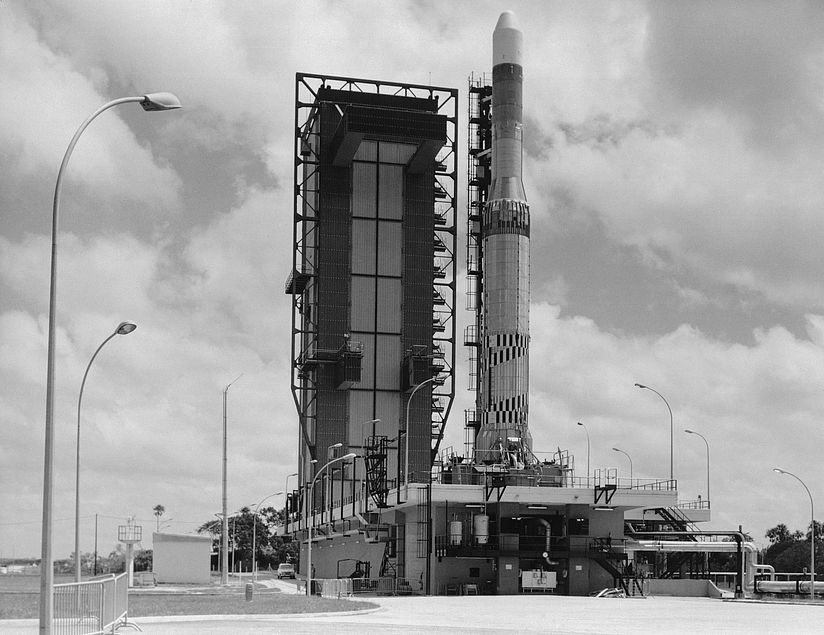Rockets
Europa-Launcher rocket
The Europa launcher was the first European attempt, in the early 1970s, to develop a three-stage satellite launcher rocket.

The F 11 was the last Europa rocket to be launched. After the failure, the programme was terminated. Photo: Deutsches Museum
The three stages came from Great Britain, France and Germany. The rocket on display is the only complete Europa launcher and represents a unique artefact of technological history.
From 1964 to 1971 the European Launcher Development Organisation (ELDO) tried to realize the 3-stage EUROPE launcher. The individual stages came from Great Britain, France and Germany. ELDO planned the construction of 15 launchers (F1-F15) to be launched in Woomera (Australia) and later in Kourou (French Guiana). None of the launchings was satisfactory. On November 5, 1971 the last EUROPE launcher F11 exploded after lift-off on the Kourou test area. The Europa rocket project was then terminated.
First stage "Blue streak"
The overall performance of Blue Streak is such that it will lift 16.300 kg (2nd and 3rd upper stages and the satellite) to a height of 60 km. The 1st stage is powered by two rocket motors using liquid oxygen and kerosene as propellants. After cut-off and separation the rocket falls back to the sea.
As early as 1957 Great Britain developed the “Blue Streak” as a military intercontinental ballistic missile. The USA contributed technical support in the form of licences from the construction of the ATLAS missile. In 1960 Great Britain cancelled the military program and offered “Blue Streak” as first stage of a European launcher. The “Blue Streak” shown here was intended to serve as first stage of the last rocket launch F15 planned.
Technical specifications:
- Length: 18,40 m
- Empty mass (at cut-off): 6 289 kg
- Total mass (fueled): 94 940 kg
- Tank volume: approx. 102 000 litres
- Tank skin: 0,5 mm thick stainless steel
- Propulsion: 2 x Rolls Royce RZ-2 liquid propellant rocket motors; Oxydator: liquid oxygen; Fuel : Kerosene RP-1
- Thrust: 2 x 667 kN
- Thrust duration: 160 sec
Second stage "Coralie"
The second Stage “Coralie”, constructed in France, transports a payload of 4.300 kg (3rd stage + satellite) from a height of 70 km to 150 km during 100 sec. The velocity of the rocket increases from 3000 m/s to 5300 m/s. After burn-out and separation the stage falls down in the sea.
The second stage malfunctioned during the first both test launches of the EUROPE launcher (F 6.1 and F 6.2). In the following launches she worked well. On display is a non operational mock up (ERF.9).
Technical specifications:
- Length: 5,50 m
- Total mass (launch): 12 019 kg
- Empty mass (burn-out): 2200 kg
- Propulsion: 4 x liquid rocket engines from LRBA (Laboratoires des Recherches Ballistiques et Aerodynamiques); Oxydator: N204 (nitrogen tetroxide); UDMH (unsymmetrical dimethylhydrazine)
- Thrust. 262 kN
Third stage "Astris"
The third stage "Astris" of the Europa rocket was developed and built in Germany by MBB in Munich and ERNO in Bremen, which formed the ASAT consortium (Arbeitsgemeinschaft Satellitenträgersystem) to coordinate their work. The payload for an orbit altitude of 500 kilometres was approximately 1,300 kilograms. The Astris projekt was the inital step in rebuilding a Geman industry, which had not developed or built rocket engines since the end of Second World War. At the end of the 1960s, more than 700 scientists, engieers and technicians were working on the Astris projekt.
The exhibit shows the the flight unit intended for the F 12 rocket launch.
Technical specifications:
- Length: 3.81 m
- Total mass (at launch): 3993 kg
- Propulsion: liquid-propellant rocket engine; Oxidator: N204 (Nitrogen tetraoxide); Fuel: Aerozin 50 (50% Hydrazin, 50% UDMH)
- Thrust: 22.56 kN
- Combustion period: 375 s
